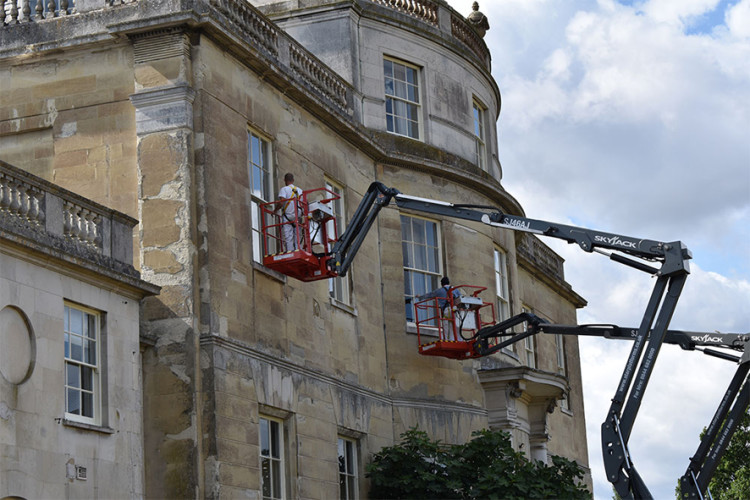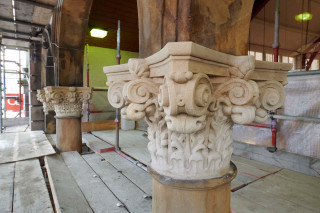In July 2013, research specialist Pye Tait Consulting and English Heritage published a report entitled Skills Research in the Historic Environment Sector, which highlighted the difficulty of defining skills issues in the ‘historic environment workforce’.
The difficulty stemmed in no small part from the fact that “there is a lack of clearly defined consensus about the definition and profile of the historic environment sector and … no single definition on what constitutes the heritage sector”.
This report estimated that there were 6,650 people working in “built heritage”. But this figure related only to those involved in the “operation of historical sites and buildings”; it did not include people carrying out traditional building work in the wider construction industry, the so-called “heritage craft workforces”.
The only attempt to quantify this resource was the 2012 government-sponsored Creative & Cultural Skills paper Mapping Heritage Craft. This research concluded that some 209,000 people are employed by heritage craft businesses, of whom nearly 170,000 used heritage craft skills and knowledge for the majority of their time.
So while it is understood that there’s an acute shortage of heritage construction skills, the sector is not clearly defined and we have no idea what the size and shape of the workforce is.
With no official current research to look to, we have to rely for now on anecdotal evidence and what we see to be true in the marketplace.
Heritage skills – stonemasonry, carpentry, metalwork, plastering, roofing and so forth – are generally carried out by small specialist companies. On small jobs they operate as principal contractor and on larger schemes they work as subcontractors to larger companies.
And this pool of skills is dwindling. Across construction as a whole, 45% of the workforce is over 45 years of age, according to the latest figures. And the lack of training in traditional crafts means the heritage workforce is ageing at a greater rate than average.
Much has been said about the need to attract young people into construction, and excellent work is being done to change the perception of our industry. We are slowly overturning the belief that construction is a dirty, male-oriented industry and that it is poorly paid.
According to recent research by the CITB, a career in construction is only slightly less well-paid than in the finance sector which, if true, is surely something we ought to be more vocal about when talking to young people considering career options.
If the lack of consensus across the heritage sector is one thing, the lack of cohesion in the construction industry is another. The incentive to train new recruits in these highly-skilled and specialised trades is compromised by the industry’s protectionism and insularity.
Most of the industry operates in a competitive market, on tight margins, and so the sharing of knowledge and skill is restricted by the environment in which we operate. Many craft specialists understandably share the view of one stonemason who said: “Why would I spend money training someone who might then leave me for a competitor, when the expense of that training may cost me contracts which will then go to my competitor, who hasn’t borne the same cost?”
Why indeed? As long as the industry continues to operate in competitive silos, this will continue to be the case.

In April 2019 representatives from contractor Sir Robert McAlpine addressed the Chartered Institute of Building (CIOB) Conservation Conference and issued a call to arms for interested parties from across the sector to come together to find a solution to apprenticeships and training.
The response was overwhelming. At a subsequent meeting, representatives from CIOB, English Heritage, Historic England, the Prince’s Foundation, Historic Royal Palaces and the Landmark Trust came together with plasterers, stonemasons, carpenters, representatives of tier-one contractors and specialist subcontractors to discuss the problem.

There was unanimous recognition of the fact that nobody can solve this problem alone and that while there is excellent work being done on an individual basis, the scale of the challenge requires a united solution.
Pye Tait is currently completing a new study looking the skills needed to meet forthcoming demand, which should allow some academic rigour to be applied to the problem in order to find a solution.
The Institute of Conservation (ICON) and Historic England will be releasing their Labour Market Intelligence toolkit shortly, which may well prove to be another useful method of gathering data to assess the shortfall.
In collaboration with a number of contractors and other industry bodies, CITB is now looking into the viability of setting up a new heritage skills training college, together with satellite colleges wider afield. This would complement existing mainstream skills training that focuses on modern materials and techniques and would also help to ensure that traditional crafts are available where modern equivalents would be inappropriate.
This is important for the maintenance and repair not only of cherished historic buildings, but also the huge number of more modest buildings constructed using traditional materials and skills prior to the Second World War.
As modern methods and materials – cavity walls, reinforced concrete, plastics and composites, for example – emerged last century, many traditional crafts and materials found themselves relegated to history and regarded by the mainstream as quaint or even obsolete.
Fewer new buildings would employ these techniques and many older structures have suffered the indignity of having inappropriate and damaging modern materials used in their maintenance and repair.
It’s not as if we weren’t warned. In 1877 William Morris, designer and co-founder of the Society for the Preservation of Ancient Buildings, said we should: “treat our ancient buildings as monuments of a bygone art, created by bygone manners, that modern art cannot meddle with without destroying. Thus, and thus only, shall we escape the reproach of our learning being turned into a snare to us; thus, and thus only can we protect our ancient buildings, and hand them down instructive and venerable to those that come after us.”
The challenge facing the heritage sector today is to harness our “modern art and learning” in a manner that is sympathetic to our historic environment. We cannot compromise the authenticity of that which we are working to preserve, or else why preserve it?
Although the industry risks losing its traditional craft skills, it is increasingly able to harness new and previously unimagined technologies to assist with even the most time-honoured techniques.
Digital technology can de-risk construction projects and offers a great opportunity for understanding the built asset. A good recent example is the immeasurable benefit of the 3D digital ‘point cloud’ model to the restoration of the cathedral of Notre Dame in Paris.
But most heritage professionals would agree that the preservation and continuity of our traditional skills is as much a part of our heritage as the buildings themselves.
• Hannah Prowse spent eight years with Sir Robert McAlpine, latterly as preconstruction manager for special projects. She is now head of national projects at English Heritage.
This article was first published in the March 2020 issue of The Construction Index magazine.
UK readers can have their own copy of the magazine, in real paper, posted through their letterbox each month by taking out an annual subscription for just £50 a year. Click for details.
Got a story? Email news@theconstructionindex.co.uk




